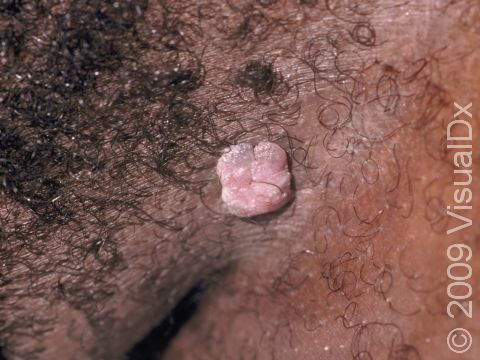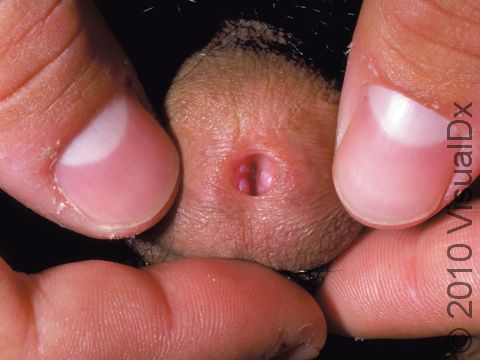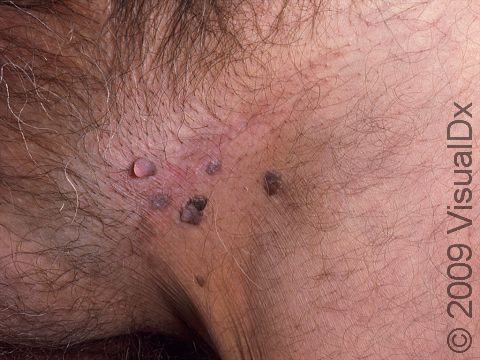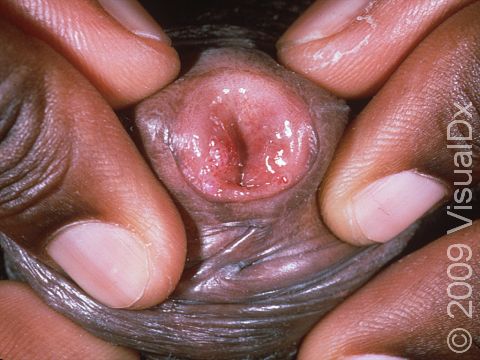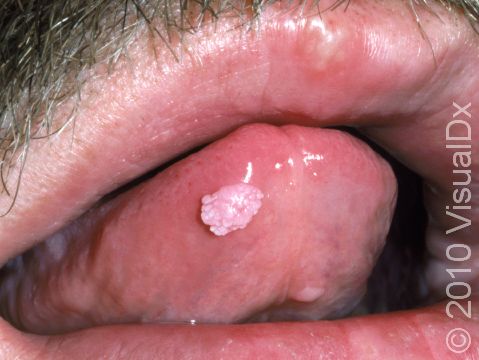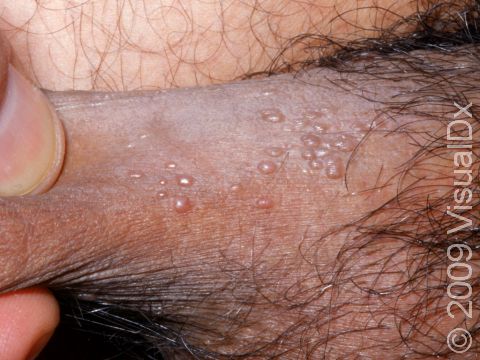Genital Wart (Condyloma Acuminatum)
Condyloma acuminatum is the medical term for genital warts, which are an infection spread through skin-to-skin contact during sexual activity. The warts are caused by a virus called the human papillomavirus (HPV). There are more than 30 strains of HPV that cause warts, and some of the strains are serious and can cause some cancers, including cervical cancer. There is no cure for HPV, but there is a vaccine that is available through a doctor to prevent the strains of HPV that cause cancer. However, a person who has had the vaccine can still get genital warts.
Warts often go away on their own, but if they do not, a doctor can remove the warts one by one. Removing the warts does not cure the affected person of HPV, and the warts can come back at any time. Because the warts are spread through skin-to-skin contact, condoms are not always protective against warts, though condoms are a good idea to use to prevent many other sexually transmitted diseases.
In 2006, the FDA approved the first HPV vaccine (Gardasil®). It protects against 4 strains of HPV that cause 70% of cervical cancers and 90% of genital warts. The HPV vaccine is a series of 3 shots over a 6-month period. In the US, Gardasil is approved for girls/women and boys/men ages 9–26. The vaccine is most effective when given before an individual becomes sexually active, but it can be given after sexual activity has begun.
Who's At Risk?
Genital warts are the most common sexually transmitted disease and affect millions of people. At least one-half of sexually active men and women are infected with HPV at some point. A person can be infected without any visible signs of infection. In women, persistence of the infection can lead to cervical cancer. Men who have perianal and penile warts have a small chance of developing squamous cell skin cancer, but this risk is higher if the person is immunosuppressed with HIV, anti-rejection drugs (organ transplant), or chemotherapy.
Genital warts can recur, either from the same original infection or from re-infection with a different HPV type. It is almost impossible to tell the source of the virus, as warts may appear weeks to months after infection occurs.
Signs & Symptoms
Genital warts appear as small 1– to 2-mm smooth bumps or larger warty, cauliflower-like lesions. They can be white, gray, or skin colored. They appear on the labia, vagina, penis, scrotum, anus, skin around the anus, and groin folds. They do not cause any symptoms.
Self-Care Guidelines
Genital warts can be prevented by abstaining from sexual activity and having as few sexual partners as possible. Since HPV is so prevalent, every new partner increases your chances of becoming infected with HPV. Because there are no symptoms, there is no way of being certain that your partner is not infected. Using condoms cannot completely protect you from HPV, since vaginal or anal penetration does not need to occur to contract the virus.
Treatments
Genital warts cannot be cured. The individual lesions can be treated, but the virus is virulent and exists beyond the visible borders of the lesions. Lesions can recur frequently.
Destructive therapies include the following: freezing with liquid nitrogen (cryosurgery), burning (electrocautery or laser), application of topical therapies such as podophyllin solution, imiquimod 3.75% or 5% cream, or cidofovir gel, and injection of alpha-interferon, an antiviral drug.
Wait to have sex for at least 2 weeks, after the areas are well healed and you can see no warts.
In immunosuppressed patients, spontaneous resolution may occur when the immunosuppression is reversed. Therefore, conservative strategies should be used.
Make sure to tell the doctor if you could be pregnant.
Visit Urgency
You do not need to have visible warts to be contagious, as the virus may be in a latent or “resting” phase. However, when warts are visible, the infection is considered active and is definitely contagious. A healthy immune system usually clears the infection on its own, but if you are sexually active, you should seek treatment to reduce the chance of passing the virus to other partners.
If your partner has been diagnosed with warts, you should be checked for infection. For women, a Pap smear is done to look for any signs of abnormal cervical cells, which can be the first sign of cervical cancer. This should be done annually if you previously had an abnormal Pap smear and every few years as a routine health check-up. For men, the genital area is visually inspected. Even if that check is normal, you may still get warts or cervical cancer in the future.
Trusted Links
References
>Bolognia, Jean L., ed. Dermatology, pp.1224-1228, 1698-1699. New York: Mosby, 2003.
Freedberg, Irwin M., ed. Fitzpatrick’s Dermatology in General Medicine. 6th ed., pp.1086, 2121, 2440, 2460. New York: McGraw-Hill, 2003.
Last modified on August 16th, 2022 at 2:45 pm

Not sure what to look for?
Try our new Rash and Skin Condition Finder
